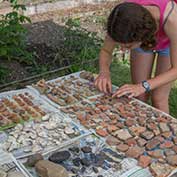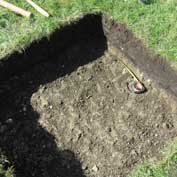In 2014 and 2015 under the auspices of Jigsaw Cambridgeshire and Gamlingay Archaeology Group (GamArch), four test pits were dug in East Hatley to see what of interest lies beneath our soil.
Simon Keith reports on what they found – first the 2015 digs.
Following a similar exercise last year (se below), two more 1m x 1m test pits were opened in East Hatley: the first on Saturday 5th September at the rear of The Manor House and the second the following day in a paddock near the footpath to the former St Denis’ church.
Both digs were well supported by local residents of East Hatley and GamArch members – and we also had the benefit of advice and support from Jemima Woolverton of Jigsaw Cambridgeshire.
We are all grateful to the owners for their enthusiastic support and logistic supplies (particularly tea and biscuits): the Wilsher family at The Manor House and Mervyn Lack and Linda Hudson at 34 East Hatley who own the paddock.
The first pit was about 6m from Manor House – which replaced a house built by the Castell family and demolished in 1684 and, as far as we know, is the oldest house site in East Hatley.
There were finds of a domestic nature which are still being assessed. As might be expected from such a location, the ground had been much disturbed over the years – some of the disturbance became clear when we reached a line of clay land drains.
The second pit in the paddock revealed a marked burnt surface at 20 cm below ground level; in four more small exploratory pits, there was similar burnt material which seemed to indicate the burnt surface extended at least 6m east to west and with similar dimensions north to south.
So what burnt down and when? Was it a building? Was it a barn, perhaps a tithe barn? Was it simply a rick? We do not know, but perhaps one day we will. There were finds in this pit below the burnt surface, which are also being assessed. There’s a slightly longer report, with photos, on the GamArch website.
The 2014 test pit report
Over the weekend of 25 / 27th July 2014, two test pits were dug in East Hatley. This is a brief report:
A demonstration test pit was dug with instruction by Jemima Woolverton of Jigsaw Cambridge at the Manor House on Friday, July 25th. It was very well attended by East Hatley and Gamlingay people.
The logistics were excellently arranged by Mark and Gill Wisher (tea, coffee, biscuits, awnings to keep off the sun, water, tables, chairs).
There were a lot of finds which, I suppose might be expected of a site so near an old house. We got down to a cobbled path at just over 0.5m and it was the undisturbed clay below this. The finds have been washed and bagged.
A second test pit was dug on land, belonging at the time to David Fisher and Becky White, about 50m south of St Denis church on Sunday, 27th July.
About 10 people attended and worked on it. We were fortunate that Zinnie Denby-Mann came as she has a degree in archaeology and gave useful advice.
There were many fewer finds than on Friday and much less domestic detritus – lots of small red brick fragments, some small bits of burnt wood, a tile and what I think was a ridge tile plus lots of stones, all in very compact grey clay.
There was a layer of gravelly stuff at about 0.35m and undisturbed yellow clay at about 0.8m. There was no evidence this site was close to a dwelling. Sample finds washed and bagged.
There’s more about this dig, with photos, in the GamArch website archives.
What is a test pit?
Test pitting is a way of sampling the archaeological evidence of an area, writes Simon Keith.
Such exercises have been carried out in many villages, particularly in the Eastern Counties, including, in our area, in Potton and Meldreth.
A series of 1m x 1m x 1m pits are dug at a number of sites and the findings recorded systematically at various levels at which they are found. It can yield valuable archaeological results.
These projects are often community activities with many people, including children, involved sharing the excitement of discovery.
“By digging and analysing their own archaeological test-pit, they’re creating one part of a huge jigsaw,” says Professor Carenza Lewis. “The more pieces we have, the clearer and more accurate is the picture.”
If these articles have whetted your appetite to know more about digging for history, Jigsaw Cambridgeshire has some very useful Step-by-step guides on its website (and much more too!)
First published on the original Hatley website in 2014 and 2015; minor changes made on 21st September 2018.



